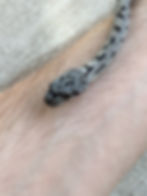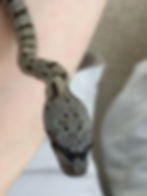On the Border: Baird's Rat Snakes
- Carlton Carnivores
- Dec 13, 2019
- 5 min read

My first snake ever was a corn snake; classic beginner's animal, comes in a lot of color morphs, localities, and variations, and that variety is one of many things that makes it such a popular pet. That they are easy to handle, don't get huge but get big enough to still be impressive to many people, and very inquisitive also makes them attractive.
However, Pantherophis guttatus is just one of many species of rat snake that inhabit North America. Multiple genera even are found across the continent, and some come in colors and patterns you'll never see in any corn morph. Within the genus Pantherophis is this very close relative, the Baird's Rat Snake (P. bairdi). It doesn't have a hundred genetic mutations to play with, and doesn't live in environments so accessible as the corn does, but Baird's are an amazing species in their own right and worthy of focus for many reasons.

P. bairdi is a relatively localized species compared to many other rat snakes, endemic to western Texas and Northern Mexico (in much the same areas as the Trans Pecos ratsnake Bogertophis subocularis, though not the same habitat niche). Particularly it is found in the Trans Pecos and Big Bend regions of the former, and along the mountain chains extending from Big Bend southward though Mexico into north-central Tamaulipas. It is a mountain and plateau endemic, preferring locations with rocky outcroppings and deep cracks and crevices to secret away in and especially wooded or heavily vegetated locations adjacent to such areas. Rarely if ever are they found in lowland or desert areas; in Big Bend National Park for example, they will be found within the Chisos Mountains in the center of the park or within the higher hills bordering the desert regions along the northern and western park edges, but almost never out on the open plains surrounding the Chisos (which is more the realm of the Trans Pecos ratsnake).
This species is capable of reaching well over 6 feet in length at maturity, though more commonly they average between 3-5 feet in length in the wild and in captivity. They are a slender-bodied species, designed supremely for climbing and maneuvering in unstable environments or squeezing through small spaces, and they are skilled hunters of small rodents, lizards, and birds. Thus, they are very similar in length and prey selection to corn snakes, but a lighter built animal by comparison (if sometimes only barely; some can still develop a fair heft with age). The most unusual aspect of the Baird's though, in my opinion, is the drastic change in coloration they experience from hatching to maturation. The pair featured here, Jacob and Leah, show quite well the standard coloration of juveniles: light ashen gray patterned with darker gray, brown, or black blotches, narrow saddles, and speckling of the individual scales. As they grow though, this pattern and the overall color is completely lost; even as of writing this, since the photos here were taken Leah (who for some reason is growing much faster than Jacob, despite being the more shy feeder) has begun to shift appearance.


As the Baird's rat snake ages, the blotched pattern will be lost, each slowly lightening from the center until they fade out completely and are replaced with a series of two to four longitudinal lines that run down the length of the body (similar to the muddier looking wild forms of corn snake). These lines aren't always clear, rather being almost an overwash on top of the background color and sometimes even appearing nonexistent, leaving only the background. Throughout their range, this species varies highly in that background though; morphs they may not have, but locale variations abound. Some may develop an almost solid silvery blue sheen across their whole body, others may retain a silver head but a tan or yellowish overwash on the rest of the snake. Most commonly perhaps though, and when developed in stark contrast also the most sought after, many individuals maintain scales that are partly gray or silver, but the rear edges and the skin between the scales develop colors anywhere from dull to bright yellow (often more so near the head, which is typically a more solid silver, brown, or dull to flaming reddish or orange), various shades or orange, to even peach, pink, or rich salmon. Overlain as this color is by the silver or brown, it almost gives a washed out or even "cracks over lava" sort of look that makes adult Baird's rats some of the most subtly beautiful rat snakes out there. The higher amount of bright undertones there are compared to the silver overtone, often the more desirable the snakes become as well. Mine are both carriers of a hypomelanistic gene, which means while they as adults should be phenomenal themselves with the silver-over-orange/salmon pattern, their offspring may possess almost no silver overlay and be primarily those bright orange and pink colors with whitish overlay instead.

In terms of care, once again this is a species very similar to the corn snake (though adults may like conditions a bit drier, natives as they are to desert mountain ranges). Cages should be at least long enough for them to stretch most of the way out if not have room to spare (that means for adults, a 3-5 foot long cage minimum is necessary), and adults especially enjoy having some head room as well with things to climb on. Hiding places are a must, with preferably at least a couple in the tank (though funnily enough, it's not uncommon for these snakes to decide to sit on top of their little houses rather than actually utilize them for the intended purpose). They are a diurnal species, commonly active in the daytime, though will also occasionally move around at night; that they will often be out and about when we are though makes them great display animals. Water dishes too should be sturdy and not easily tipped over, and these snakes will occasionally use them for baths and so should be large enough to also house the snake it goes with.
Temperature is fairly standard, though perhaps slightly warmer than most other common rat snakes (conditions given to the others will often suit the Baird's just fine though). A hot spot of 90-95 degrees Fahrenheit and a cooler end of 75-80 usually suffices. Feeding this species typically comes with ease; mine don't like to be watched when they're feeding, Leah especially, and need the food to just be left with them, but even babies are typically ready right off the bat to take pinkie mice so no struggle with finding lizards or scenting, and keeping them on frozen-thawed mice through adulthood is no issue for most.
And, of course, this is a species that is typically very amenable to handling. Babies, like in so many other species, will often be more defensive, and may even retain at least a tendency to rattle their tails into adulthood, but if approached gently rarely bite and are almost never an issue once out of the cage. They are a very agile, active, and inquisitive species though, and so will give a good workout for the handler and can easily slip away if not watched carefully; a close eye while out and a very secure tank are a must. The babies I have take no more than a few seconds to make it from the hand to the top of my head, and quite like to stretch out to nearby objects.



Lastly, of course: the Baird's rat snake is a serious investment of time, even if they're not much more expensive than many of the common corn and other rat snake morphs. They too can easily live for 10-20 years, maybe more, and so are a very long-term pet. So if you are looking into one (and you'll probably be able to come back to this blog for more convincing in the future, as I'll revisit these two when they start developing their adult garb), make sure you're ready for a pet that will be around for quite some time, a member of the family just as much as any dog or cat may be.
